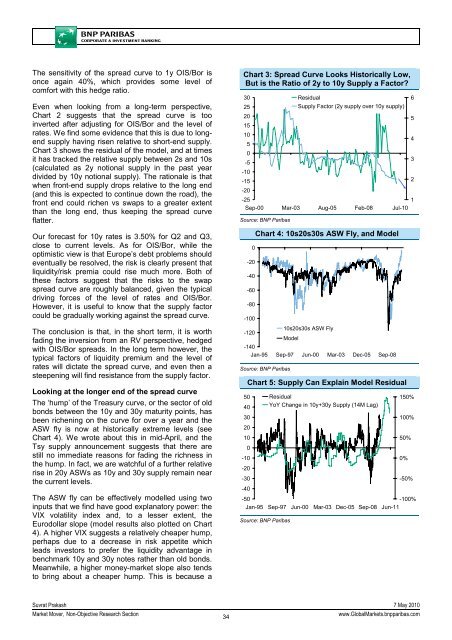Market Economics | Interest Rate Strategy - BNP PARIBAS ...
Market Economics | Interest Rate Strategy - BNP PARIBAS ...
Market Economics | Interest Rate Strategy - BNP PARIBAS ...
Create successful ePaper yourself
Turn your PDF publications into a flip-book with our unique Google optimized e-Paper software.
The sensitivity of the spread curve to 1y OIS/Bor is<br />
once again 40%, which provides some level of<br />
comfort with this hedge ratio.<br />
Even when looking from a long-term perspective,<br />
Chart 2 suggests that the spread curve is too<br />
inverted after adjusting for OIS/Bor and the level of<br />
rates. We find some evidence that this is due to longend<br />
supply having risen relative to short-end supply.<br />
Chart 3 shows the residual of the model, and at times<br />
it has tracked the relative supply between 2s and 10s<br />
(calculated as 2y notional supply in the past year<br />
divided by 10y notional supply). The rationale is that<br />
when front-end supply drops relative to the long end<br />
(and this is expected to continue down the road), the<br />
front end could richen vs swaps to a greater extent<br />
than the long end, thus keeping the spread curve<br />
flatter.<br />
Our forecast for 10y rates is 3.50% for Q2 and Q3,<br />
close to current levels. As for OIS/Bor, while the<br />
optimistic view is that Europe’s debt problems should<br />
eventually be resolved, the risk is clearly present that<br />
liquidity/risk premia could rise much more. Both of<br />
these factors suggest that the risks to the swap<br />
spread curve are roughly balanced, given the typical<br />
driving forces of the level of rates and OIS/Bor.<br />
However, it is useful to know that the supply factor<br />
could be gradually working against the spread curve.<br />
The conclusion is that, in the short term, it is worth<br />
fading the inversion from an RV perspective, hedged<br />
with OIS/Bor spreads. In the long term however, the<br />
typical factors of liquidity premium and the level of<br />
rates will dictate the spread curve, and even then a<br />
steepening will find resistance from the supply factor.<br />
Looking at the longer end of the spread curve<br />
The ‘hump’ of the Treasury curve, or the sector of old<br />
bonds between the 10y and 30y maturity points, has<br />
been richening on the curve for over a year and the<br />
ASW fly is now at historically extreme levels (see<br />
Chart 4). We wrote about this in mid-April, and the<br />
Tsy supply announcement suggests that there are<br />
still no immediate reasons for fading the richness in<br />
the hump. In fact, we are watchful of a further relative<br />
rise in 20y ASWs as 10y and 30y supply remain near<br />
the current levels.<br />
The ASW fly can be effectively modelled using two<br />
inputs that we find have good explanatory power: the<br />
VIX volatility index and, to a lesser extent, the<br />
Eurodollar slope (model results also plotted on Chart<br />
4). A higher VIX suggests a relatively cheaper hump,<br />
perhaps due to a decrease in risk appetite which<br />
leads investors to prefer the liquidity advantage in<br />
benchmark 10y and 30y notes rather than old bonds.<br />
Meanwhile, a higher money-market slope also tends<br />
to bring about a cheaper hump. This is because a<br />
Chart 3: Spread Curve Looks Historically Low,<br />
But is the Ratio of 2y to 10y Supply a Factor?<br />
30<br />
25<br />
Residual<br />
Supply Factor (2y supply over 10y supply)<br />
6<br />
20<br />
5<br />
15<br />
10<br />
4<br />
5<br />
0<br />
-5<br />
3<br />
-10<br />
-15<br />
2<br />
-20<br />
-25<br />
1<br />
Sep-00 Mar-03 Aug-05 Feb-08 Jul-10<br />
Source: <strong>BNP</strong> Paribas<br />
0<br />
-20<br />
-40<br />
-60<br />
-80<br />
-100<br />
-120<br />
Chart 4: 10s20s30s ASW Fly, and Model<br />
10s20s30s ASW Fly<br />
Model<br />
-140<br />
Jan-95 Sep-97 Jun-00 Mar-03 Dec-05 Sep-08<br />
Source: <strong>BNP</strong> Paribas<br />
50<br />
40<br />
30<br />
20<br />
10<br />
-10<br />
-20<br />
-30<br />
-40<br />
Chart 5: Supply Can Explain Model Residual<br />
0<br />
-50%<br />
-50<br />
-100%<br />
Jan-95 Sep-97 Jun-00 Mar-03 Dec-05 Sep-08 Jun-11<br />
Source: <strong>BNP</strong> Paribas<br />
Residual<br />
YoY Change in 10y+30y Supply (14M Lag)<br />
150%<br />
100%<br />
50%<br />
0%<br />
Suvrat Prakash 7 May 2010<br />
<strong>Market</strong> Mover, Non-Objective Research Section<br />
34<br />
www.Global<strong>Market</strong>s.bnpparibas.com
















